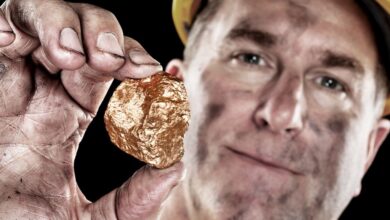LEOCOR GOLD DEFINES 7KM GOLD/COPPER TREND AT THE BAIE VERTE PROJECT, NW NEWFOUNDLAND
Leocor Gold Inc. has released results of the 2021 exploration activities and 2022 exploration plans on the company’s Baie Verte project located near Anaconda Mining’s Pine Cove mine and Rambler Metal’s Ming mine in northwestern Newfoundland.
The 2021 work program included soil sampling, GT Probe sampling, geophysics, and lidar and high-resolution drone imagery surveys. Highlights include:
- Multiple targets identified along a seven-kilometre, northeast trending zone of anomalous gold in soils and a four-kilometre subparallel trend of anomalous copper (plus/minus gold) in soils with results up to 1,601 parts per billion (ppb) gold and 2,862 parts per million (ppm) copper;
- Indications of two styes of mineralization on the project including VMS (volcanogenic massive sulphide) style copper (plus/minus gold-zinc) mineralization and structurally controlled gold mineralization with similarities to the nearby Pine Cover mine.
Based on the results of the 2021 program, the company is also planning a phase 1 drilling campaign consisting of a minimum of 30 Rotary Air Blast (RAB) drill holes on at least four of the gold and copper targets. The RAB drill program is expected to commence in June, 2022, and is designed to evaluate the targets for potential follow-up diamond drilling. In addition to the RAB drilling, the company is also planning to complete additional soil sampling, prospecting, geologic mapping and geophysical surveys on the project.
“The soil results over the Dorset project were better than I could have predicted and really shows our project’s and, in a broader sense, Newfoundland’s exploration potential,” said Shawn Ryan, Leocor’s technical adviser. “Here we have an area that has seen a lot of previous exploration work, from gold to base metal, and the detailed 2021 soil program outlined a brand new 6.5-kilometre mineralized gold trend that has not been previous seen. And the soil work also outlined a nice base metal copper-zinc target measuring 1,200 m by 400 m sitting directly across from the old Terra Nova base metal deposit. Having one of these anomalies is impressive but having two is exceptional. It should be an exciting year for Leocor with the planned follow up drilling,” continued Mr. Ryan.
“These results at Dorset and the larger Baie Verte project are very positive developments,” said chief executive officer Alex Klenman. “We’re eager to follow up on the discovery of the seven-kilometre gold-copper trend and get drills going. The RAB program will help us vector in on the best diamond drill locations and we want to move forward as quickly as possible. These are compelling targets and we’re committed to prioritizing our exploration plans at Dorset and the larger Baie Verte project,” continued Mr. Klenman.
2021 exploration program
A two-phase surface geochemistry program consisting of 5,313 soil samples and 449 GT probe samples was conducted in late 2021. A lidar survey was flown over the entirety of the project during early season efforts to assist in later program planning and logistics. In addition, a ground MAG-VLF (magnetic very-low frequency) survey was conducted to aid in geological and structural interpretation along an eight-kilometre segment of the Baie Verte fault system, which is interpreted to be a significant control on gold mineralization across the property.
Soil sampling
A total of 5,313 soil samples were collected on 100-metre spaced lines and 25-metre spaced samples with soil lines-oriented northwest-southeast to cross dominant geological contacts and structures. Sample depths ranged from 30 centimetres to 110 cm and targeted C-horizon material. Assays for the samples ranged from trace to 1,601 ppb Au and from trace to 2,862 ppm Cu. These samples defined a series of linear, northeast trending, gold anomalies over a seven-kilometre trend across the property, including the Dorset, Copper Creek and FMB trends. In addition, they defined two zones of strongly anomalous copper (plus/minus gold) in soils along a four-kilometre subparallel trend, and include the Copper Creek and Copper Creek South trends. The individual targets are discussed in more detail below.
GT probe sampling
In addition to the soils, a total of 449 GT probe samples were collected over 14 lines on the Copper Creek, Copper Creek South and Dorset Trends. The GT probe is a track mounted device designed to drive a cased hole through the soil profile to the bedrock interface with samples collected from the final 30 cm of the hole, and analyzed for gold and other pathfinder elements. Samples were spaced at five-metre intervals and ranged from 30 cm to 420 cm in depth. Assays for the samples ranged from trace to 1.97 grams per tonne (g/t) gold and from trace to 400 ppm Cu.
Dorset Trend (gold)
The Dorset trend consists of a 2.5-kilometre-long gold in soil anomaly located approximately three km south of the Baie Verte town site and extending from historic Dorset and Gunshot prospects (rock samples up to 57.2 g/t Au) to the southwest. The target has soil results of up to 1,601 ppb Au and includes 33 samples over 100 ppb Au. Six GT probe lines were also placed across the target and include results up to 1.19 g/t Au.
FMB trend (gold)
The FMB trend (Five Mile Brook trend) is characterized by a two-kilometre gold-arsenic soil trend that is four km south-southwest of Baie Verte and less than one km off of the main highway. This target has soil values of up to 1,536 ppm As and 263 ppb Au and is locally associated with anomalous molybdenum, antimony and zinc. A rock sample returning 1.31 g/t Au was also collected along the trend.
Copper Creek Southwest (gold)
Copper Creek Southwest is located approximately one kilometre southwest of the main Copper Creek trend and consists of a 1.5-kilometre gold-in-soil anomaly with samples up to 1,266 ppb Au. The area has historically been called the Albatross target and was trenched and drilled by Noranda in the 19XXs; returning historic grab samples of up to 30 g/t Au and drilling results of 1.0 g/t Au over seven metres.
Copper Creek trend (copper and gold)
This is a two-kilometre-long southwest trending Au-in-soil anomaly with highs of 867 ppb Au. The northern area of the trend is defined by a 500-metre-by-1,000-metre copper anomaly with highs up to 2,860 ppm Cu that has association with anomalous Zinc. This target is approximately one kilometre north of the Dorset trend and immediately east of historic Terra Nova Copper deposit.
Copper Creek South (copper and gold)
The Copper Creek South target is located between Dorset and Copper Creek trends approximately two kilometres south of Baie Verte, immediately north of the LaCie highway. This area has soil results up to 416 ppb Au and 1429 ppm Cu. The location of Au and Cu anomalies is on trend with historic targets in the Dorset trend to the southwest.
Interpretation
Follow-up investigation of the gold and copper anomalies is continuing, however, initial results indicate that the gold in soil anomalies are often associated with anomalous arsenic, and occur along lithologic contacts interpreted to be northeast trending shear zones near the boundaries of, or within, gabbroic rock units. This style of mineralization is analogous to the Anaconda’s Pine Cove mine, where gold is hosted in altered gabbroic and volcanic rocks. The zones of anomalous copper (plus/minus gold) is often associated with zinc and shows strong similarities to VMS-style mineralization hosted within the nearby by Terra Nova copper deposit.
2022 exploration program
Based on the 2021 exploration results, the company is planning an initial RAB drilling program on Dorset. The program will consist of a minimum of 30 drill holes and will test both gold and copper targets on the Dorset, Copper Cree, Copper Creek Southwest and FMB trends. The drilling is anticipated to commence in early June, 2022, and is designed to evaluate the targets for potential follow up diamond drilling.
In addition to the RAB drilling, geologic mapping, soil sampling, rock sampling and geophysical work will be conducted to extend mineralized trends and aid in geologic interpretation on the project.
Assay methodology and quality assurance/quality control (QA/QC)
The soils samples for the 2021 program were prepared at Eastern Analytical Laboratories. The samples are dried at 60 degrees Celsius, sieved to minus 80 mesh and then air couriered to Bureau Veritas labs in Vancouver, B.C., where the samples were analyzed using AQ201+U method (15-gram aqua regia digest with 37-element ICP-MS)
GT Probe and rock samples were prepared and analyzed by ALS Global Laboratories of Moncton, N.B. The entire sample was first crushed to 70 per cent passing minus two millimetres and then splitting off and pulverizing a 250-gram split to 85 per cent passing minus 75 microns. A 0.5-gram cut of the pulp was then analyzed by ME-ICP41, which is an aqua regia digestion followed by ICP-AES analysis for 35 elements. Gold was analyzed for by AA-AU23 using a 30-gram charge for a standard fire assay with an AA finish. If Au results were over 10 g/t, a second 30-gram charge was used for a standard fire assay with a gravimetric finish.
The reported work was completed using industry standard procedures, including a quality assurance/quality control program consisting of the insertion of certified standard, blanks and duplicates into the sample stream.
About Leocor’s Dorset project
The Dorset gold project is a 275-hectare gold exploration project, held within the company’s larger Baie Verte project, located south of the Pine Cove gold mine, and features multiple zones of high-grade gold mineralization. The Main Dorset target includes three historic showings, referred to as the Dorset 1, 2 and 3 showings. Grab samples from the showing returned grades up to 407.9 g/t Au. Historic drilling includes DDH 87-1, which intersected 9.5 g/t Au over 1.3 m (MacDougall and Walker, 1988).
Historic select sampling at the Braz zone (within the Dorset trend) returned values up to 314 g/t Au. Historic channel sampling across the vein returned 9.5 g/t Au over 0.4 m, 5.7 g/t Au over 0.5 m and 1.2 g/t Au over 0.65 m (MacDougall, 1990).
Copper Creek (1,025 ha) hosts a number of gold prospects and copper occurrences associated with extensive alteration/shear zones developed within a thrust-faulted sequence of Advocate (ophiolite) Complex rocks, intermediate to silicic volcaniclastic rocks, and micro gabbroic dikes/sills of the Flatwater Pond (cover sequence) group. Historical results at the Copper Creek-Biarritz zone include “values ranging from 1.3 to 16 g/t Au from grab samples and a combined assay of 3.9 g/t Au over 4.0 m from detailed chip sampling.” Additionally, “300 m SW [southwest] along strike exposed a five-metre-to-10-metre shear zone with similar alteration returned, which returned sporadic values up to 9.2 g/t Au from grab samples.” Noranda drilled several diamond holes in the area, including A-88-7, which returned 0.66 g/t Au over 1.5 m, and A-88-9, which returned 3.11 g/t Au over 0.5 m. (MacDougall, 1989).
The data reported here is historic in nature and has not yet been verified by a qualified person. Leocor has relied on the information supplied in the Noranda assessment reports (quoted above) and from information found in MODS (mineral occurrence data system) published by the Newfoundland Department of Natural Resources.
National Instrument 43-101 disclosure
Jodie Gibson, PGeo, consultant, a qualified person under National Instrument 43-101, has reviewed and approved the technical information in this news release.
About Leocor Gold Inc.
Leocor Gold is a British Columbia-based resource company involved in the acquisition and exploration of precious metal projects, with a current focus in Atlantic Canada. Leocor, through outright ownership and earn-in agreements, currently controls several gold-copper projects in prime exploration ground located within the prolific Baie Verte mining district. Leocor’s Bae Verte portfolio includes the Dorset, Dorset Extension, Copper Creek and Five Mile Brook projects, creating a contiguous, nearly 2,000-hectare, exploration corridor. The company also controls the 6,847-hectare grassroots Startrek project near Gander, as well as three district scale land packages in north-central Newfoundland known as Robert’s Arm, Hodge’s Hill and Leamington, (collectively, the Western Exploits) representing over 144,000 hectares (1,440 square kilometres) of prospective exploration.
We seek Safe Harbor.

